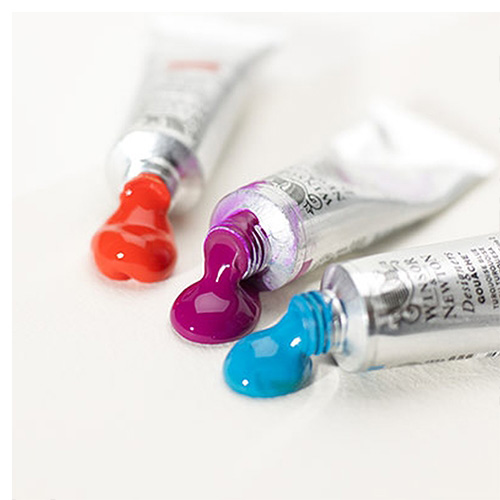
Gouache, pronounced gwaash, is often referred to as opaque watercolour and is the ideal paint choice for textile designers when generating artwork for print design.
It consists of pigment, water and a binding agent.
Gouache is designed to be used as an opaque painting method, but has the versatility to be watered down to desaturate the colour. It is similar to watercolour in that it can be rewet and reused (great for those on a budget) and results in a velvety matte finish. The difference in watercolour and gouache is the ratio of binding agent and pigment, gouache has a much higher ratio which makes it a heavier opaque medium.

Gouache dries very quickly and its possible to overpaint already dry paint with lighter or darker colours without activating the colour underneath. Light shades generally dry darker and dark shades dry lighter.
There are a number great brands who supply gouache in a range of colours.
Some of our favourites include:


- Winsor and Newton –
- W&N are the frontrunners in gouache development, mainly being used by fine artists, designers, Illustrators and commercial artists as their gouache has high concentrations of pigment for solid colour results. An industry favourite with a wide selection of 82 colours to choose from. Their colours are vibrant, quick drying and offer great control and opacity. Costwise youre looking between $10 and $26 fo 14mls depending on the series.
- Art Spectrum –
- Slightly more economical than W&N, great for students. Their price point is is around $10 for 22.5mls. An excellent starting point for new designers experiemnting with colour. Their gouache is quick drying and offers a variety of colours in slightly larger volumes than other brands.
Adding Mediums to gouache

Gouache is water based therefore when adding different mediums the characteristics are altered, for example adding an acrylic medium will result in a glossy finish. There are several considerations to take when adding mediums to gouache:
- Each colour should be tested by mixing it with the medium and leaving it to dry. There may be a colour reaction between some of the pigments and the medium due to the alkalinity of the acrylic resin. This is most likely to occur with pinks, violets and magentas.
- There may also be a chemical reaction when mixing the medium and colour together, beware of any granular or gelatinous effects which may occur, again due to the alkalinity of the resin.
- Using acrylic mediums will increase the transparency of gouache, particularly if using the gloss medium.
- Water resistance can be achieved by adding small amounts of Acrylic Matt Medium to your gouache colour.
- If you add too large a proportion of medium this will result in a ‘plastic’ look to the colour.
Ideal brushes for Gouache
For water-based work use a sable or a soft synthetic brush as gouache can be quite heavy. Synthetic brushes are a cheaper alternative to natural hair brushes and quite often have an excellent point and can carry colour very well. Try a variety of brushes when you start out and you will soon find your favourite to work with.
Ideal paper for Gouache
Any paper made for watercolors is appropriate for gouache, If youre working with a lot of gouache which is quite heavy go for a heavier textured paper between 200 and 300 gsm.

